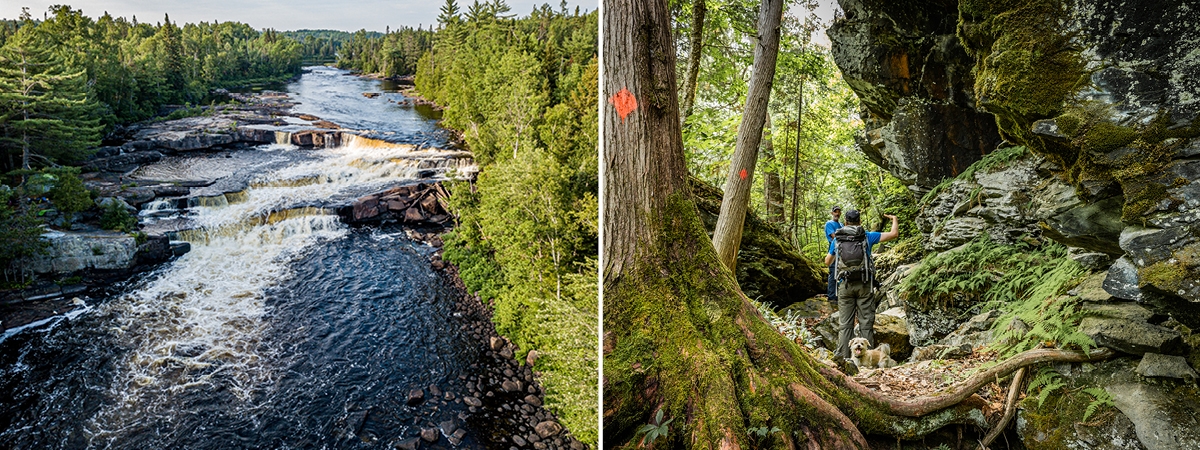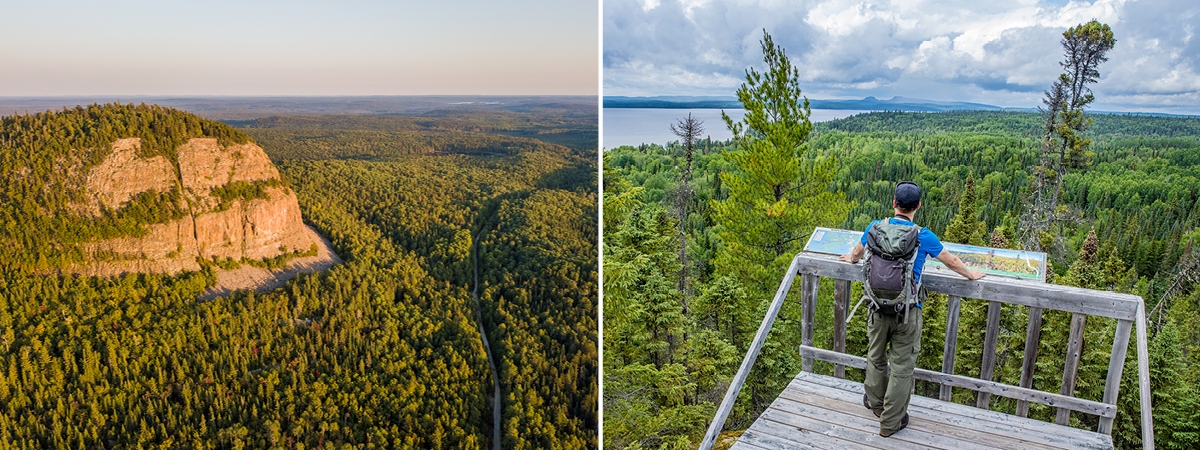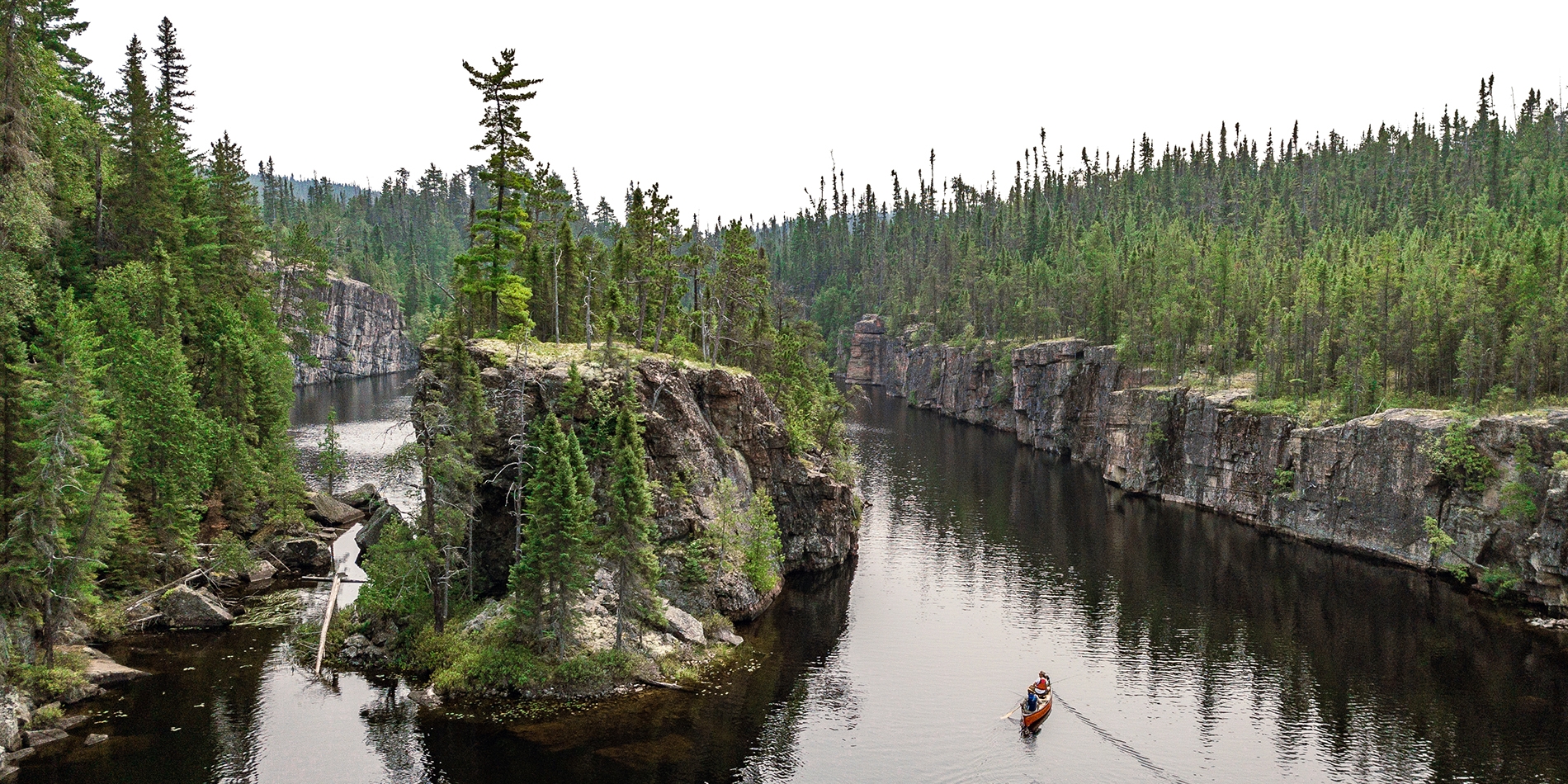Vast and natural territory
Abitibi-Témiscamingue has a rich natural and cultural heritage. Due to its large area, it is located in a territory of extreme diversity, including lakes, rivers, river (Harricana river), forests, hills and rocky capes.
Geographic location
The westernmost region of Quebec, Abitibi-Témiscamingue extends from the Ontario border in the west to Mauricie and Outaouais in the east, then from Outaouais and Ontario to the south (46th parallel) to Nord-du-Québec in its northern limit (49th parallel).
Relief
The passage of huge glaciers over the region, the last of which dates back 10,000 years, has shaped the landscape of Abitibi-Témiscamingue, flattening the peaks of the mountains and filling in the bottom of the valleys, resulting in a relatively flat territory in Abitibi. and a little more rugged in southern Témiscamingue. Responding to global warming, the glacier slowly retreated to successively transform Témiscamingue, then Abitibi, into two huge lakes: Lake Barlow and Lake Ojibway. After more than 2,000 years of existence and clay sedimentation, these vast bodies of water drained and reorganized into an important network of lakes and rivers, following the raising of the shield after the melting of the ice. The bodies of water thus follow the natural slopes and depressions of the reshaped landscape. Combined with a relatively flat relief, the clay soils favored the development of important wetlands conducive to the establishment of moose.

Hydrography
Abitibi-Témiscamingue enjoys an immense natural territory fragmented by water, while 9% of the territory is made up of bodies of water. 20,034 lakes and rivers (12% of the area of the territory) with abundant ramifications, spectacular waterfalls, banks made up of magnificent rock faces, sandy beaches, rocky capes and verdant forests embrace the landscape. The region has 9 bodies of water with an area of more than 100 km2, often riddled with narrow bays. In addition, it is full of esker lakes sheltering a rich biodiversity and fed by a network of tunnels that contain the purest water in the world, resulting from the melting of glaciers. Two large hydrographic basins, flowing towards opposite poles, the St. Lawrence and the Baie-James, divide the waters of the territory on either side of the watershed line that crosses the region from west to east.
Area and forest cover
The region covers 65,064 km2, making it the 4th largest region in Quebec. Abitibi-Témiscamingue extends over more than 300 km in the north-south axis and almost as much in the east-west axis. Its forest cover, which represents 11% of that of Quebec, extends over 85% of the entire regional territory. This wooded area is made up of 89% public land, which makes it a vast playground for the practice of nature and adventure activities, resorts, hunting, fishing, etc.
It is a huge territory with a low density of inhabitants (2.6 inhabitants/km2 in 2021). A unique place where nature imposes its presence with uncrowded outdoor activity sites creating an impression of tranquility and freedom.
Végétation et perspective visuelle
The diversity of the region's landscapes is a real eye-catcher thanks to the presence of two forest realities with distinctive charms, the boreal forest in Abitibi and the mixed forest in Témiscamingue. The south of the Témiscamingue territory is located on a plateau cut with a lot of relief forming small valleys enclosed in a harmonious and gentle landscape. A very large diversity of hardwoods and conifers composed of species such as white pine, red pine, sugar maple, oak and yellow birch characterizes the landscape. There are very old forests with huge trees.
The further north you go, the more homogeneous the forest. Trees lose height and diameter and the landscape flattens. More and more spruce trees are visible. Visual perspective increases. We see landscapes over incredible distances, several tens of kilometers. The air becomes increasingly dry and the cloudiness decreases. When you rise in altitude on the many hills of Abitibi, you can see up to 50 kilometers away. We switch to large expanses as we approach the Far North. Abitibi is characterized by the typical presence of balsam fir, white and black spruce and white birch, as well as jack pine, larch and cedar. In the northwest of the region, in the municipality of Duparquet, live some of the oldest trees in the east of the continent, up to more than 800 years old. Among other things, there is the oldest tree in Quebec, a thuja (cedar) about 1000 years old.

Wildlife
The woods of Abitibi-Témiscamingue are teeming with animals, big and small, black bears, moose, wolves, hares, partridges, foxes and lynx. Nearly three hundred species of birds roam the sky and waters of the region and about fifty species of fish are present in the lakes and rivers, as well as many beavers. Many hunting, fishing and trapping enthusiasts have the opportunity to practice these activities close to home. Thanks to the extent of forest roads, comparable in size to the road network, the regional forest has the particularity of being highly accessible. More than 6,952 basic shelters (2019) are scattered there, representing 72% of all those in Quebec. Moose hunting is particularly popular; 24,716 moose hunting licenses were issued in the region in 2021, mobilizing a quarter of the adult population, when the time comes, and at the same time disrupting the agendas of businesses and regional organizations. In addition to the hunters, each year there are nearly 100,000 fishermen, of whom 40,000 live in the region, making fishing one of the most popular activities.
Generous climate
Four distinct seasons follow one another in Abitibi-Témiscamingue. Severe but dry winters with significant snow cover that remains on the ground give way, when the time comes, to hot summers. As the territory extends over a very large area (300 km along its north-south axis), there are significant climate variations within the region itself. Warmer and less snowy than Abitibi, Témiscamingue enjoys an earlier spring and flowering and a later fall.
Moreover, the sun sets half an hour later than in Montreal during the summer solstice, thus offering enviable additional hours of weekly light. As a result, bees forage longer and produce more honey. The peculiarities of the climate also cause the berries to be sweeter and the trees to have denser fibre. Abitibi-Témiscamingue also benefits from bluer than blue skies. This regional particularity is often cited among the great assets of the region, along with the northern lights and the spectacular colorful sunsets.
Population
Abitibi-Témiscamingue is home to a lively and innovative population of 148,242 (2021) cultivating an intimate relationship with nature. It is made up of multiple origins and three languages are spoken there: French is the first language with 94.8% of the population, English 3.6% and finally the Algonquin language 1.6%. The region is rich in the millennial presence of Anicinabek communities (over 8,000 years). The territory is the proud heart of the Anicinabe nation, with seven of Canada's eleven communities being established there.


